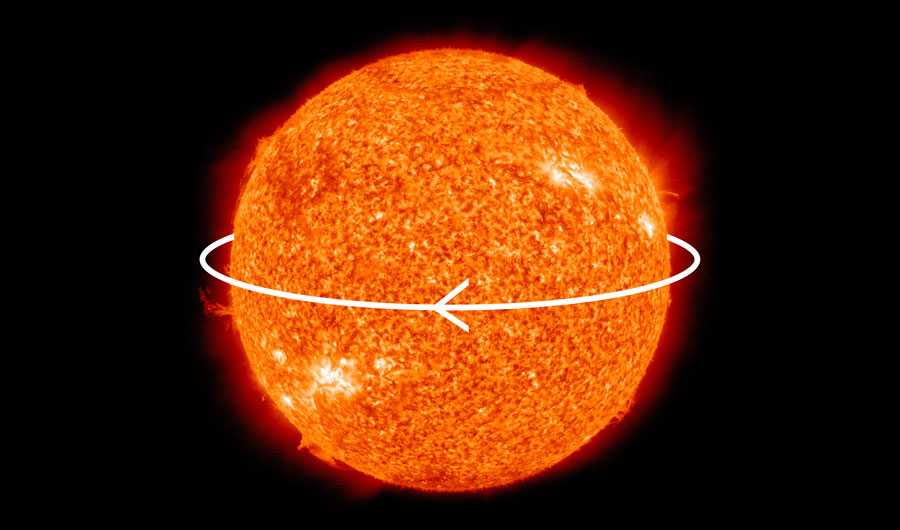Escaping Photons Slow Down the Surface Rotation of the Sun

Composite image by Yuen Yiu, Staff Writer, Sun image by NASA/SDO via Wikimedia Commons
(Inside Science) -- Sunlight can pack a real punch. Light leaving the surface of the sun pushes back ever so slightly as it escapes, slowing down the star’s rotation at its topmost layers, according to new research.
The sun does not rotate evenly on its axis, a fact that has long puzzled scientists. Its surface rotates more slowly than its inner layers, and its poles rotate more slowly than its equator. These differences cause knots to form in the sun’s magnetic fields and plasma, which can snap and unleash powerful torrents of energy called coronal mass ejections and solar flares. Supercomputer simulations are helping scientists understand the equatorial difference, but there hasn’t been a good explanation for why the sun’s outermost layers rotate more slowly than its interior, said Jeff Kuhn, a physicist at the University of Hawaii and lead author of the new research.
The answer relies on two bedrock principles of physics: Einstein’s theory of special relativity, and Newton’s third law of motion. Einstein’s theory explains that a beam of light carries both electromagnetic force, in the form of a wave, and momentum, in the form of a particle. Newton’s third law specifies that momentum is conserved for an isolated system; in other words, every action has a reaction. So photons leaving the sun can change the sun's momentum, like a fired bullet kicking back the gun.
“Energy momentum and angular momentum are basic physical properties of any thing, and they are conserved,” said Hugh Hudson, a solar physicist at the University of California, Berkeley, who was not involved in the research.
The sun is a hot ball of plasma that radiates light because its core is a fusion reactor. As hydrogen fuses to form helium, energetic photons are released, which take about a million years to make their way to the surface. Because the photons are born within the rotating sun, they pick up its angular momentum, Kuhn said. When they leave, they carry away some of that momentum, pushing back on the sun with a twisting force called a torque.
“The sun is really quite bright, so even though they are just lowly photons, in accumulation, they have a significant effect on the outer part of the sun,” Kuhn said. “This is just another effect of relativity -- that light, energy and mass are all different manifestations of the same physical principles.”
The photons' pushback only affects a thin outer layer that accounts for about 5 percent of the sun’s radius. Based on calculations of the solar plasma’s behavior and the expected torque provided by escaping photons, Kuhn and colleagues expected to find a 2 percent difference in rotation speed between the uppermost layers of the sun’s outer skin, called its photosphere, and its deeper layers. To check the true spin speeds, they used the Helioseismic and Magnetic Imager on the Solar Dynamics Observatory satellite.
The measurements relied on another dynamic solar behavior: It rings like a bell. Deep within the sun, heat-related turbulence sends sound waves shooting outward. The sound waves reflect off the sun’s surface and bounce around. Solar physicists use these vibrations to probe the sun’s interior, in a process called helioseismology, but Kuhn and his team instead used them like a target. The researchers were able to pinpoint the sound waves moving around on the sun’s face, and then also peer at them from the side. This three-dimensional view was key to proving how the sun’s outermost layer was moving with respect to the inner layers.
The effect is small, but over the 4.5-billion-year life of the sun, the angular momentum loss from light is just enough to account for the difference in rotation speed, they say. The new research appears in Physical Review Letters.
The work was complex, but the notion was very simple, Hudson said.
“It would be very surprising to me if this idea had not been discovered by other people,” he said. The difference is that now, astronomers can measure the speed change using helioseismology methods, he added.
Angular momentum loss in the sun has been investigated in the past. The sun constantly streams energetic particles into space, and previous research suggested this solar wind could be to blame for the differential rotation at the equator and poles. At the sun’s poles, a full rotation takes about 36 days, while at its equator, a full spin takes less than a month. But mathematical models now show that the sun's internal currents, and the fact that the sun is made of several layers, likely play the key role in that strange scenario.
That differential rotation is a prime suspect in the generation of coronal mass ejections and flares, which spew harmful radiation toward Earth and its human-built satellites. Hudson said he doubted the conflicting speeds at the top layers play a major role in driving space weather, but scientists need to do more work to find out. The Daniel K. Inouye Solar Telescope, currently under construction on the Hawaiian volcano Haleakalā, will be able to probe these relationships in more detail, Kuhn said.
The photon-braking effect would be true for any star; the brighter the star, the more pronounced the slowdown, he added. As such, the finding is important for studying the life cycle of not just the sun, but any star -- and of the planets that orbit them, scattered throughout the galaxy.

